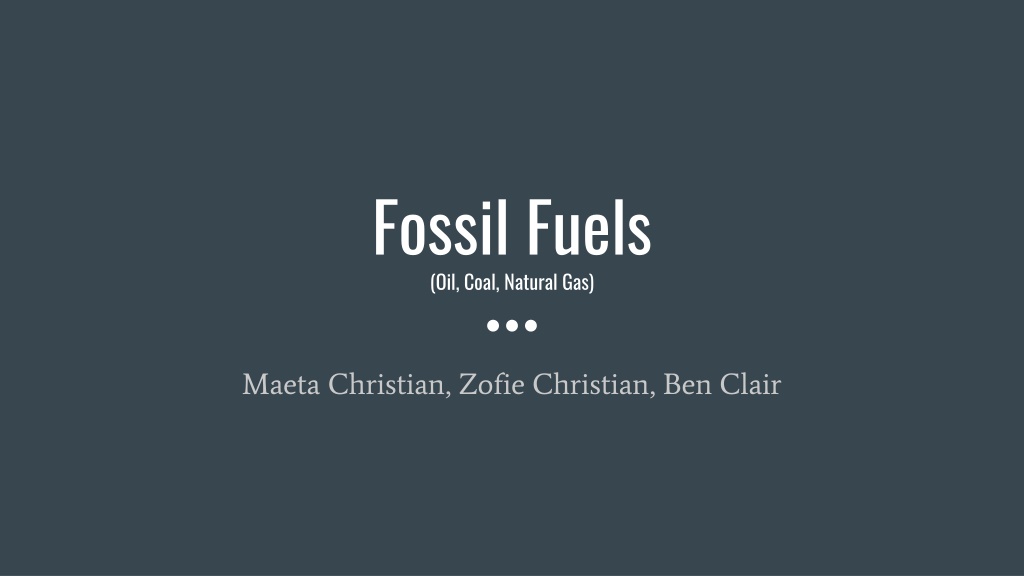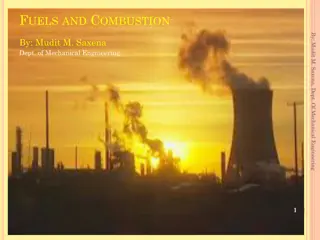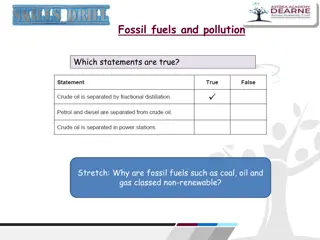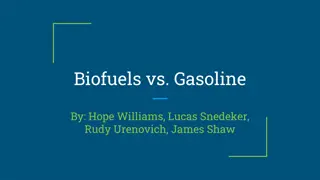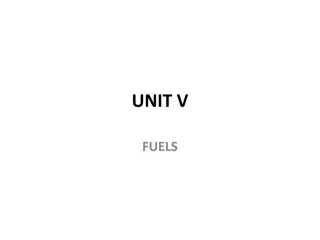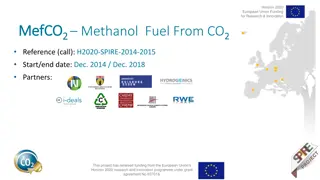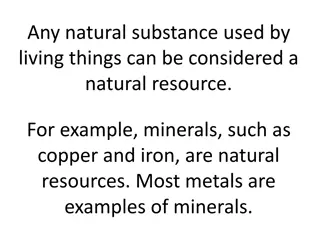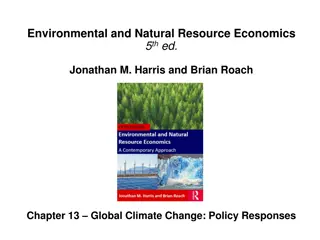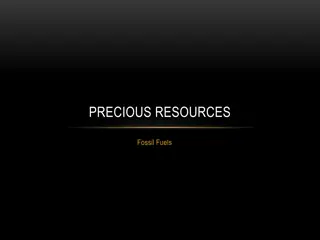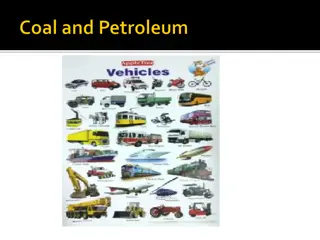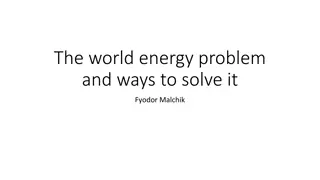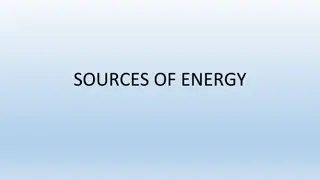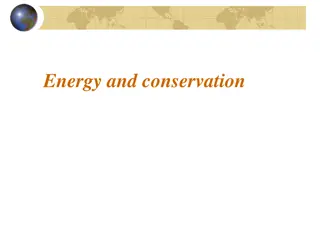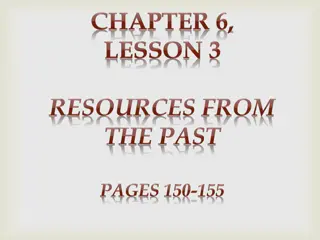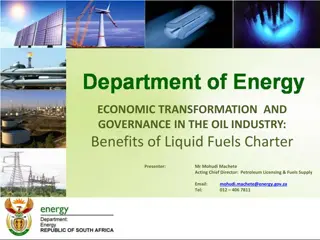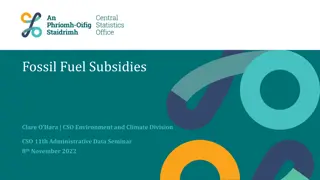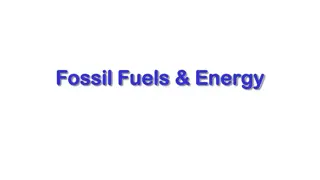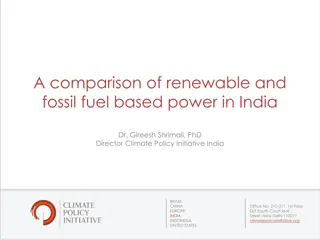Understanding Fossil Fuels: Advantages, Disadvantages, and Impact
Fossil fuels like oil, coal, and natural gas have both advantages and disadvantages. They offer cheap energy with a high power output but contribute to pollution and are non-renewable. The method of processing fossil fuels in power plants is explained, highlighting their impact on the environment and human health. Helpful formulas for power plant problem-solving are provided, along with a practical example of calculating power output and thermal energy in a coal power plant.
Download Presentation

Please find below an Image/Link to download the presentation.
The content on the website is provided AS IS for your information and personal use only. It may not be sold, licensed, or shared on other websites without obtaining consent from the author. Download presentation by click this link. If you encounter any issues during the download, it is possible that the publisher has removed the file from their server.
E N D
Presentation Transcript
Fossil Fuels (Oil, Coal, Natural Gas) Maeta Christian, Zofie Christian, Ben Clair
Advantages Cheap High power output (energy density) Used easily by many engines Large distribution network
Disadvantages Main source of atmospheric pollution Leakage Contribute to the greenhouse effect Non-renewable Extensive storage facilities needed
Method, Explained Fossil fuels are generally processed in a power plant, where coal is burned to create energy. The process starts by converting water to steam with the energy provided by the coal. The steam is then used to turn a turbine, which in turn causes the coils of a generator to rotate in a magnetic field, therefore creating electricity by electromagnetic introduction. Finally, the steam is condensed back into water, which will be recycled within the system.
Impact Particles impact people s breathing Cost: ~$5.3 trillion ~ of human caused emissions come from burning fossil fuels Takes millions of years for fossil fuels to form
Helpful Power Plant Problem-Solving Formulas Efficiency = Power input power output Power = Energy / time Useful energy total = energy efficiency Distance = rate time Q = mc?T
Problem Solving (Part One) #4. A coal power plant with 30% efficiency burns 10 million kilograms of coal a day. (Take the A coal power plant with 30% efficiency burns 10 million kilograms of coal a day. (Take the specific energy of coal to be 30 MJ/kg.) specific energy of coal to be 30 MJ/kg.) A. Calculate the power output of the plant. Calculate the power output of the plant. Begin by converting MJ/kg to J/kg. Then, find the energy total by multiplying the specific energy of the coal (in J/kg) and the number of kilograms used per day. Next, multiply that number by the given efficiency to find the useful energy. Finally, divide the useful energy by the number of seconds in a day. Final answer: 1.04 x 109J/s B. Estimate the rate at which thermal energy is being discarded by this plant. Estimate the rate at which thermal energy is being discarded by this plant. Find the energy total of the useless energy, being sure to divide by the number of seconds in a day. Final answer: 2.43 x 109J/s C. Use the formula ( m/ t)c( T) = 2.43 x 109J/s, plugging in the known heat capacity of water and change in temperature to solve for ( m/ t). Final answer: 1.2 x 105kg/s
Problem Solving (Part Two) #5. One liter of gasoline releases 34 MJ of energy when burned. The efficiency of a car operating One liter of gasoline releases 34 MJ of energy when burned. The efficiency of a car operating on this gasoline is 40%. The speed of the car is 9.0 m/s when the power developed by the engine on this gasoline is 40%. The speed of the car is 9.0 m/s when the power developed by the engine is 20 kW. Calculate how many kilometers the car can go with one liter of gasoline when driven at is 20 kW. Calculate how many kilometers the car can go with one liter of gasoline when driven at this speed. this speed. Determine the total energy output by multiplying the the specific energy of the gasoline by the efficiency of the car. Then, divide the total energy output by the power of the engine (making sure to convert kW to W). Finally, plug the information into the formula distance=(rate)(time) to solve for distance. Final answer: 6,120 m or 6.12 km
Problem Solving (Part Three) #6. A coal A coal- -burning power plant produces 1.0 GW of electricity. The overall efficiency of the burning power plant produces 1.0 GW of electricity. The overall efficiency of the power plant is 40%. Taking the specific energy of coal to be 30 MJ/kg, calculate the amount of power plant is 40%. Taking the specific energy of coal to be 30 MJ/kg, calculate the amount of coal that must be burned in one day. coal that must be burned in one day. For this problem, we know that the power plant produces 1x109W of electricity. Divide this number (the total output) by the knowns: the efficiency and the specific energy (making sure to convert from MJ to J). Finally, because the number that was just solved for is in seconds, multiply by the number of seconds in a day to calculate the total amount of coal that must be burned in one day. Final answer: 72x105kg/day
References 1. Electricity Generation from Fossil Fuels. Electrical Power Generation from Fossil Fuels, www.mpoweruk.com/fossil_fuels.htm. 2. The Hidden Costs of Fossil Fuels. Union of Concerned Scientists, www.ucsusa.org/resources/hidden-costs-fossil-fuels. 3. Piccirilli Dorsey, Inc. Fossil Fuels. EESI, www.eesi.org/topics/fossil-fuels/description. 4. Tsokos, K. (2014). Physics for the IB Diploma. 6th ed. Cambridge University Press. 5. IMF: 'True cost' of fossil fuels is $5.3 trillion a year. PRI, https://www.pri.org/stories/2015-06-07/imf-true-cost-fossil-fuels-53- trillion-year 6. Energy Sources Energy.gov, https://www.energy.gov/science-innovation/energy-sources/fossil 7. The Sources and Solutions:Fossil Fuels epa.gov https://www.epa.gov/nutrientpollution/sources-and-solutions-fossil-fuels
